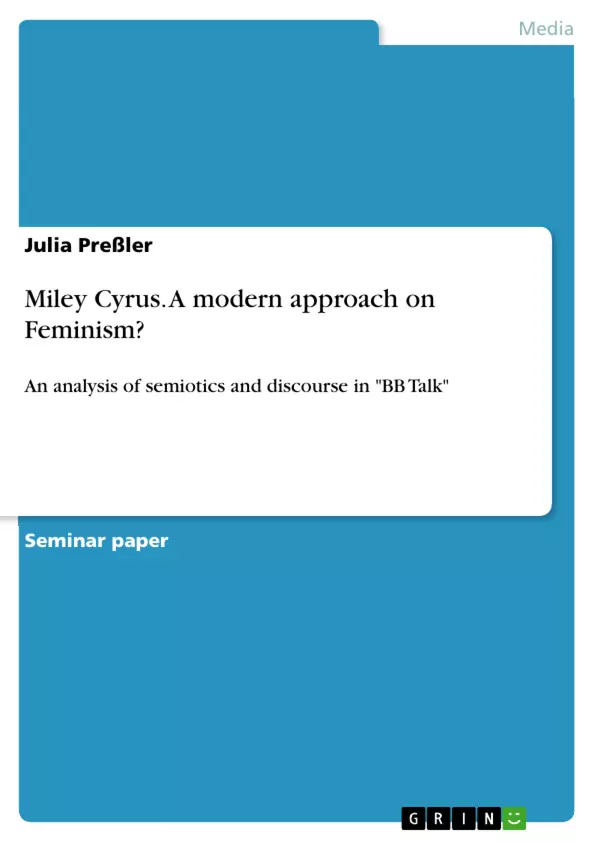In this modern world of the 21st century, where new media and influential celebrities seem to rule over teenage hood and adolescence, feminism has taken on various different, at times contradicting forms. A range of famous singers, actors, models and so on declare themselves as modern-day feminists, but seemingly fail to go into the depths of what their statements and actions actually mean and, more important, could be interpreted to mean. In the interconnected cultural spheres today’s global citizens wander, the variety of opinions and attitudes people carry around is as vast as ever and it has become almost impossible to shield oneself against influence of others. When it comes to popular culture, especially, the global influence of few people and what impact they have can be remarkable. Celebrities like Miley Cyrus, who are often seen to be role models for young girls and women, and thus conceded a special responsibility for them, are shaping the cultural dimensions of what is deemed relevant and desirable in, especially, Western culture. The issue of sexualization of young girls has been a controversy Cyrus has been located in herself, and has been commenting on, as well. Over the past few years she has created an image of a strong, independent rebel-woman who does not like to play by society’s rules, breaking out of the realms of what is deemed acceptable.
Resistance against current social discrepancies embedded in gender indifference, utilizing a certain way of style and bricolage of various cultural elements – ranging from things like personal clothing to writing a song and editing a music video to be released for the public – that seems what modern Miley Cyrus is all about.
Inhaltsverzeichnis (Table of Contents)
- Introduction
- Popular Culture and Feminism in Post-Modern Times
- Popular Culture
- 3rd Wave Feminism and the era of Post-Feminism
- 4th Wave Feminism and Sexual Empowerment
- BB Talk - An Analysis of Miley Cyrus' Cultural Identity.
- Background Information
- Discourse Analysis
- Semiotic Analysis
- Conclusion
- Sources
Zielsetzung und Themenschwerpunkte (Objectives and Key Themes)
This paper analyzes Miley Cyrus' "BB Talk" and the role she plays as a cultural icon in the context of modern feminism. By examining the semiotics and discourse within the song and its accompanying video, the paper aims to understand how Cyrus' cultural identity is shaped by and influences perceptions of female empowerment and sexuality. The paper explores the contradictions and complexities surrounding modern feminism and its intersection with popular culture.
- The evolution of feminism in the postmodern era
- The impact of popular culture on the construction of gender identity
- The role of celebrity discourse in shaping feminist ideals
- The complex relationship between female sexuality and empowerment
- The influence of popular culture on social norms and perceptions of femininity
Zusammenfassung der Kapitel (Chapter Summaries)
The introduction sets the stage for the analysis, discussing the rise of modern feminism and the complex role of celebrities in shaping cultural perceptions. It emphasizes Miley Cyrus' influence as a role model for young women and her controversial stance on sexualization. Chapter 2 explores the concepts of popular culture and feminism in the postmodern era, delving into the post-structuralist critique of binary systems and how it applies to gender roles. It also examines the various approaches to understanding popular culture, including the debates surrounding mass culture and the authenticity of cultural expression. Chapter 2.1 focuses on the concept of popular culture itself, highlighting the dynamic and interconnected nature of culture as a social process. It emphasizes the active role of the individual in shaping cultural perceptions and the significance of cultural texts in relation to their audience. Chapter 2.2 delves into the evolution of feminism, specifically the rise of the 3rd wave in the 1990s. It explores the shift from political activism to cultural engagement and the importance of addressing issues like sexuality, beauty, and fashion in the fight for gender equality. It also highlights the challenges faced by women in expressing their sexuality within a patriarchal system and the societal pressure to conform to unrealistic beauty ideals.
Schlüsselwörter (Keywords)
The core focus of this paper is the analysis of Miley Cyrus' "BB Talk" as a case study for understanding the complex relationship between modern feminism, popular culture, and the construction of female identity. Key themes include post-structuralist thought, feminist deconstructivism, popular culture, mass culture, 3rd wave feminism, female sexuality, empowerment, social norms, and the impact of celebrity discourse. The paper explores the semiotics and discourse embedded in Cyrus' work, drawing on concepts from Cultural Studies and feminist theory to decipher the messages communicated through the song and its video.
- Arbeit zitieren
- Julia Preßler (Autor:in), 2017, Miley Cyrus. A modern approach on Feminism?, München, GRIN Verlag, https://www.grin.com/document/438871



